Chapter 7. How Would You Know If People Can Learn to Reduce Anxiety?
7.1
By:
C. Nathan DeWall, University of Kentucky
David G. Myers, Hope College

7.2

Note: You will be guided through the Intro, Design, Measure, Interpret, Conclusion, and Quiz sections of this activity. You can see your progress highlighted in the non-clickable, navigational list at the right. Watch this video from your author, Nathan DeWall, for a helpful, very brief overview of the activity.
7.3

So, how would you know if people can learn to reduce anxiety? To study this question in your role as researcher, you need to DESIGN an appropriate study that will lead to meaningful results, MEASURE if people can learn to reduce anxiety, and INTERPRET the larger meaning of your results, considering how your findings would apply to the population as a whole.
For the purposes of this study, let’s assume our participants will be learning to meditate as a means of reducing anxiety. By meditate, we mean to engage in thoughtful reflection or contemplation.
We know from other researchers’ work that therapeutic meditation reduces anxiety, but let’s study whether people can learn to use meditation as a way to reduce their own anxiety.
Question
SvEpFjt7nMabPvlhtUNG3kOaBvYseA7hpi56St5asxrck454ndWdc5+hUN7PCZelPgxGrdyG9aH4GF63uI/NeYpH7acVBXolSLpN1gOwgr53hvAfkQyeqVzq2XXYMl6EANQwhTNws4XFvuWLnDas5plt4aYJCYzgj7XsyeBH46V9UPYcvZtfQSD1fHOBIsPdwZ7v8+bUx3PqEi5Qevj+TVXBZIyznrJ0pCSAR38BkPcmE0G22vv/HA6ErppQvKHfGAIkGRX6lq8OQEGzMWRP4vGy9nYZhsE1xh8A4t2gFUsoO3GQCVoGJqkDJQJ6J1mNpG4eh5rJKBFv2e7JeXA3kNY+fQifspOuXEye60ym+tPG/c9pvrMkpDYrmeUfxwNAHGyQXOdbcRn6BDYQj1WaOSGNehfnxbzpJd35T8P20GZmXoSYeXWCW+yGfXE=Click on "Video Hint" below to see brief animations describing Experiments, Naturalistic Observation, and Correlational Studies.
Video Hint
7.4
Experiments:

Naturalistic Observation:

Correlational Studies:

7.5

You have chosen Naturalistic Observation as your design, which means you want to carefully observe participants in a natural environment—outside the lab—and make notes about what they do. For example, researchers have used naturalistic observation designs to learn about how children play. They have spent many thousands of hours observing children playing in different environments, carefully tracking their behaviors, and watching for meaningful patterns.
Question
ctN/z9khaBg6lliiD0y6EfbxBl8yO18/8IB7DOLdO0iQi9HmH9asN3l0sWaMyz/Nud9V+jrocBPdZ1lvTX8Y4rpy0dfG81QFeIcsHiNlAn8TS6cB8GnaIfQw0uXBhsdIfJ2fajQLbX7CIX0Fd4r5BDA7LlxGze0ef3eAlcaINgfg11PyviTZ5vUKxnbdCBtyp0npeUvYQrgLO7Fse+foNdRTa0aDEA1b05UtCZC6VGR3CXKIblKln7o2Mi2vItET54VzqThrpk0pvIlQruZLpjfOr5UAusn9re0gCtGMZA85MDk77jk1ZQPc4M/uFNxe6NloaSKO09goWuk83gs8HnWBxQ1ZSUAVt6iVFyTDEsQQ1s1QuJsrTkwmOYhYC20xTrk9iNpVJZOJEpZkC/xTubyFZaDCrI5grFR9NHiqFKQE9KKvhqHPaF+b15LKhv+WQeGr/95EsW/Dm2ob9spAHWYIlPBgoxBc8CIazp496wQiN0PUYmpyDV7A9kKtVbnLTNe8rV5RF2WOvW1Sc8eNcwGbZ8sfuvcN5I78LEgJEAaG0mb17.6

What could we learn from these participant choices?
A small group of people who regularly meditate. Observing this group of people over time would not help you test whether people can learn to meditate in order to feel less anxious. You would instead need to have two groups to compare—those who have not learned to meditate when they feel anxious with those who have learned this skill
A small group of people who enjoy reading meditation books. Studying a group of people who enjoy reading meditation books would not help us address the question of whether people can learn to meditate to reduce their anxiety. We would instead need to have two groups to compare—people who learn to meditate when they feel anxious and people who do not learn to meditate when they feel anxious.
A small group of people who learn to meditate when feeling anxious and another small group of people who do not learn to meditate when feeling anxious. You do need to compare two groups—those who learn to meditate when feeling anxious and those who do not learn to meditate when feeling anxious. HOWEVER, you need to study a large group, not a small group of people as you would in this naturalistic observation approach, in order to determine if the idea of people learning to reduce their anxiety may apply to a larger population. You would also need to do more than observe behaviors, which wouldn’t be a clear indicator of the degree of anxiety a participant may be experiencing.
I'm not sure.
Trying to choose a sample of participants helps us realize that NATURALISTIC OBSERVATION IS NOT THE BEST RESEARCH DESIGN to test this question. Although we could use naturalistic observation to gather detailed information about a small group of people, do you think it would be appropriate to apply those findings to a larger population? Would knowing that a few people learned to use meditation to reduce anxiety tell you something about people in general? Or might it be difficult to know if something other than meditation affected their anxiety in a way that would not hold true for most people?
We’d get more helpful results by studying large groups of people, which would allow us to apply our results to a broad population. We would also want to do more than observe our participants; we would need to measure how systematic changes in meditation practices influence anxiety levels. And we would need to compare results in two groups—those who learn to practice meditation to reduce anxiety, and those who do not.
Click “Next” to go back and try again to select the most effective research design.
7.7

A small group of people who regularly meditate. Observing this group of people over time would not help you test whether people can learn to meditate in order to feel less anxious. You would instead need to have two groups to compare—those who have not learned to meditate when they feel anxious with those who have learned this skill.
A small group of people who enjoy reading meditation books. Studying a group of people who enjoy reading meditation books would not help us address the question of whether people can learn to meditate to reduce their anxiety. We would instead need to have two groups to compare—people who learn to meditate when they feel anxious and people who do not learn to meditate when they feel anxious.
A small group of people who learn to meditate when feeling anxious and another small group of people who do not learn to meditate when feeling anxious. You do need to compare two groups—those who learn to meditate when feeling anxious and those who do not learn to meditate when feeling anxious. HOWEVER, you need to study a large group, not a small group of people as you would in this naturalistic observation approach, in order to determine if the idea of people learning to reduce their anxiety may apply to a larger population. You would also need to do more than observe behaviors, which wouldn’t be a clear indicator of the degree of anxiety a participant may be experiencing.
I'm not sure.
Trying to choose a sample of participants helps us realize that NATURALISTIC OBSERVATION IS NOT THE BEST RESEARCH DESIGN to test this question. Although we could use naturalistic observation to gather detailed information about a small group of people, do you think it would be appropriate to apply those findings to a larger population? Would knowing that a few people learned to use meditation to reduce anxiety tell you something about people in general? Or might it be difficult to know if something other than meditation affected their anxiety in a way that would not hold true for most people?
We’d get more helpful results by studying large groups of people, which would allow us to apply our results to a broad population. We would also want to do more than observe our participants; we would need to measure how systematic changes in meditation practices influence anxiety levels. And we would need to compare results in two groups—those who learn to practice meditation to reduce anxiety, and those who do not.
Click “Next” to go back and try again to select the most effective research design.
7.8

A small group of people who regularly meditate. Observing this group of people over time would not help you test whether people can learn to meditate in order to feel less anxious. You would instead need to have two groups to compare—those who have not learned to meditate when they feel anxious with those who have learned this skill.
A small group of people who enjoy reading meditation books. Studying a group of people who enjoy reading meditation books would not help us address the question of whether people can learn to meditate to reduce their anxiety. We would instead need to have two groups to compare—people who learn to meditate when they feel anxious and people who do not learn to meditate when they feel anxious.
A small group of people who learn to meditate when feeling anxious and another small group of people who do not learn to meditate when feeling anxious. You do need to compare two groups - those who learn to meditate when feeling anxious and those who do not learn to meditate when feeling anxious. HOWEVER, you need to study a large group, not a small group of people as you would in this naturalistic observation approach, in order to determine if the idea of people learning to reduce their anxiety may apply to a larger population. You would also need to do more than observe behaviors, which wouldn’t be a clear indicator of the degree of anxiety a participant may be experiencing.
I'm not sure.
Trying to choose a sample of participants helps us realize that NATURALISTIC OBSERVATION IS NOT THE BEST RESEARCH DESIGN to test this question. Although we could use naturalistic observation to gather detailed information about a small group of people, do you think it would be appropriate to apply those findings to a larger population? Would knowing that a few people learned to use meditation to reduce anxiety tell you something about people in general? Or might it be difficult to know if something other than meditation affected their anxiety in a way that would not hold true for most people?
We’d get more helpful results by studying large groups of people, which would allow us to apply our results to a broad population. We would also want to do more than observe our participants; we would need to measure how systematic changes in meditation practices influence anxiety levels. And we would need to compare results in two groups—those who learn to practice meditation to reduce anxiety, and those who do not.
Click “Next” to go back and try again to select the most effective research design.
7.9

A small group of people who regularly meditate. Observing this group of people over time would not help you test whether people can learn to meditate in order to feel less anxious. You would instead need to have two groups to compare—those who have not learned to meditate when they feel anxious with those who have learned this skill.
A small group of people who enjoy reading meditation books. Studying a group of people who enjoy reading meditation books would not help us address the question of whether people can learn to meditate to reduce their anxiety. We would instead need to have two groups to compare—people who learn to meditate when they feel anxious and people who do not learn to meditate when they feel anxious.
A small group of people who learn to meditate when feeling anxious and another small group of people who do not learn to meditate when feeling anxious. You do need to compare two groups - those who learn to meditate when feeling anxious and those who do not learn to meditate when feeling anxious. HOWEVER, you need to study a large group, not a small group of people as you would in this naturalistic observation approach, in order to determine if the idea of people learning to reduce their anxiety may apply to a larger population. You would also need to do more than observe behaviors, which wouldn’t be a clear indicator of the degree of anxiety a participant may be experiencing.
I'm not sure.
Trying to choose a sample of participants helps us realize that NATURALISTIC OBSERVATION IS NOT THE BEST RESEARCH DESIGN to test this question. Although we could use naturalistic observation to gather detailed information about a small group of people, do you think it would be appropriate to apply those findings to a larger population? Would knowing that a few people learned to use meditation to reduce anxiety tell you something about people in general? Or might it be difficult to know if something other than meditation affected their anxiety in a way that would not hold true for most people?
We’d get more helpful results by studying large groups of people, which would allow us to apply our results to a broad population. We would also want to do more than observe our participants; we would need to measure how systematic changes in meditation practices influence anxiety levels. And we would need to compare results in two groups—those who learn to practice meditation to reduce anxiety, and those who do not.
Click “Next” to go back and try again to select the most effective research design.
7.10

You have chosen a Correlational design, which means you want to examine the association between two or more variables. For example, when testing whether sleep deprivation relates to slower mental processing, researchers have recruited a large group of people and measured (1) how much they sleep and (2) their mental processing speed. This allowed researchers to determine whether the two variables of sleep deprivation and slower mental processing are related. (They are.)
Question
5EQAGa3NuNHnBMUiGR35jBcr7chnKtjvN8bZXPRkaDOzpMxvWqb1ZZJNXdPRo9zhMrKtTriEQ4kQOp+zS7UH12H5oXtcHd4t9tLZpqIjsKoCXWik58aNFO6t5VSgkdep3Lk2WJ5xRnKhQzu2rqlvrLf4yVK4vVZ0cksI26Q5qzOa24EsEHlARtG1FwD9RS9kBVJ8vMrJ+QjNmR/9wpFIWSqNBlvj8N2idSkZIbKl4zNeSBNq0wxUfg==7.11

One possible correlational design would examine the association between meditation behavior and anxiety levels. In fact, researchers have found that these two variables are related—the more people meditate, the less anxiety they feel. But this does not tell us whether the meditation CAUSES people to feel less anxious, or if perhaps naturally less anxious people enjoy meditating. We need to determine whether learning to meditate, compared with not learning to meditate, causes people to reduce their anxiety.
So, CORRELATIONAL IS NOT THE BEST RESEARCH DESIGN for this study. We’d get more helpful results by using a different design.
Click “Next” to go back and try again to select the most effective research design.
7.12

Nice work! You have correctly chosen to use an Experimental design for your study.
Next, you need to choose the most appropriate study participants.
Question
I8HzBliovs0euFpdqxECsID6juoF934LuE4m88XrEYnwvpLiACwCrNoS5H6kxGgzcQ1NRDIFcYKzoXmazw9AtVCrwwPMv/phgTWPXjYb0V83SdaM47LXLwdFxujFxDRS/xCHwFNz2JcCXEPyeJdaK8zWKNN0i6oiTQ0E2gg4xk0Qldyqy813IcwHVcxJH9MG/EQFvQaVAEQ+VgZPDkq2tHbCgRN0PnMMaEPOazkEgfaeX3utvJLVyHToHMLpzH2H/LyeGoA5QShdYAYg+QHHe+BKPfFBqK/wJT1cchzVRXozP92Yk+qSRtfgdeczJb4uAD5cyXefuYL2AqfL0eXeBCJUEWoE4G0SYmdVEOWm15qL3bJ5l/YmKrESoiI1BQEhFHfZSuU+mzGJ7TsqLZei9QXB3UsCAAAGuAdz6efe4UmktlmH0QNwOV06NqFqna/SZnMSvCdrdrK+jQhq6Z4/Tu6aMT01+I1OtHpLJmcwBM9zkyCJZpZA5rIkFisd10ihwe7ei2KG4tq3gNo+99llipjan5Ia9UzMSVJJCKg8f2Tei5zr/xWRfnP2xWo1tin5aObtMW+PxdL2Y3p0SIKxLCt5+3/04v66sxw77onVbhl9j1RQKlcWzdwjQIUY+nlHrnD93LIkaywcECDX2lvsqQGil/qHWZusJtFk79OVfvW2tTnV78HRGjp+rQmG6eEVs/gobkXJV5lhfERTHjBbxw==7.13
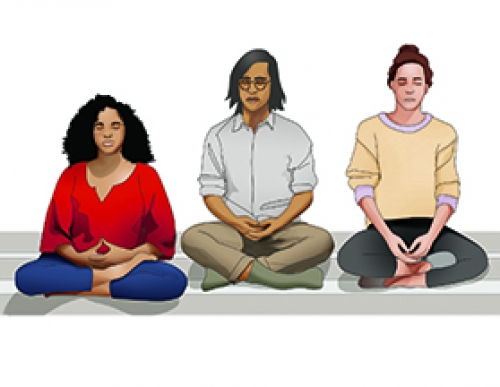
You chose A group of people who regularly meditate, but that is NOT CORRECT.
To know whether people can learn to reduce their anxiety, you need to be able to compare TWO groups—those who learn to mediate when they feel anxious AND those who do not learn to meditate when they feel anxious. This way you can know whether learning to meditate, compared with not learning to meditate, causes people to reduce their anxiety.
Click “Next” to go back and try again to select the best participants for your experimental study.
7.14

You chose A group of people who enjoy reading meditation books, but that is NOT CORRECT.
Knowing that people enjoy reading meditation books does not tell us whether they would be appropriate study participants. To know whether people can learn to reduce their anxiety, you need to compare people who learn to meditate when they feel anxious with people who do not learn to meditate when they feel anxious.
Click “Next” to go back and try again to select the best participants for your experimental study.
7.15

You chose A group of people who have family members who meditate and another group of people who do not have family members who meditate, but that is NOT CORRECT.
Knowing whether people have family members who do, or do not, meditate does not tell us whether they would be appropriate study participants. We need to compare two groups—those who learn to meditate when they feel anxious and those who do not—in order to know whether people can learn to reduce their anxiety with meditation.
Click “Next” to go back and try again to select the best participants for your experimental study.
7.16

Good job! You have correctly chosen to use an Experimental design. You will randomly assign participants either to meditate when feeling anxious, or not to meditate, in order to determine whether people can learn to meditate to reduce anxiety. You also selected an appropriate sample of participants—a group of people who you instruct to meditate when they experience anxiety, and another group of people you instruct not to meditate when they experience anxiety. Now you need to determine how best to MEASURE the relevant behavior or mental process, which in this case is how much people learn to reduce anxiety through meditation.
Learning to reduce anxiety will involve the principle of negative reinforcement—strengthening a response by reducing or removing an aversive stimulus. For example, people learn to take a painkiller because it reduces or removes the aversive stimulus of pain. In this study, we want to know whether learning to meditate will reduce or remove the aversive stimulus of anxiety. So, let’s first review positive and negative reinforcement.
7.17
Here’s a quick overview of Types of Reinforcers from the text. After you’ve read this carefully, click “Next” to continue with selecting the best way to measure if people can learn to reduce their anxiety through meditation.
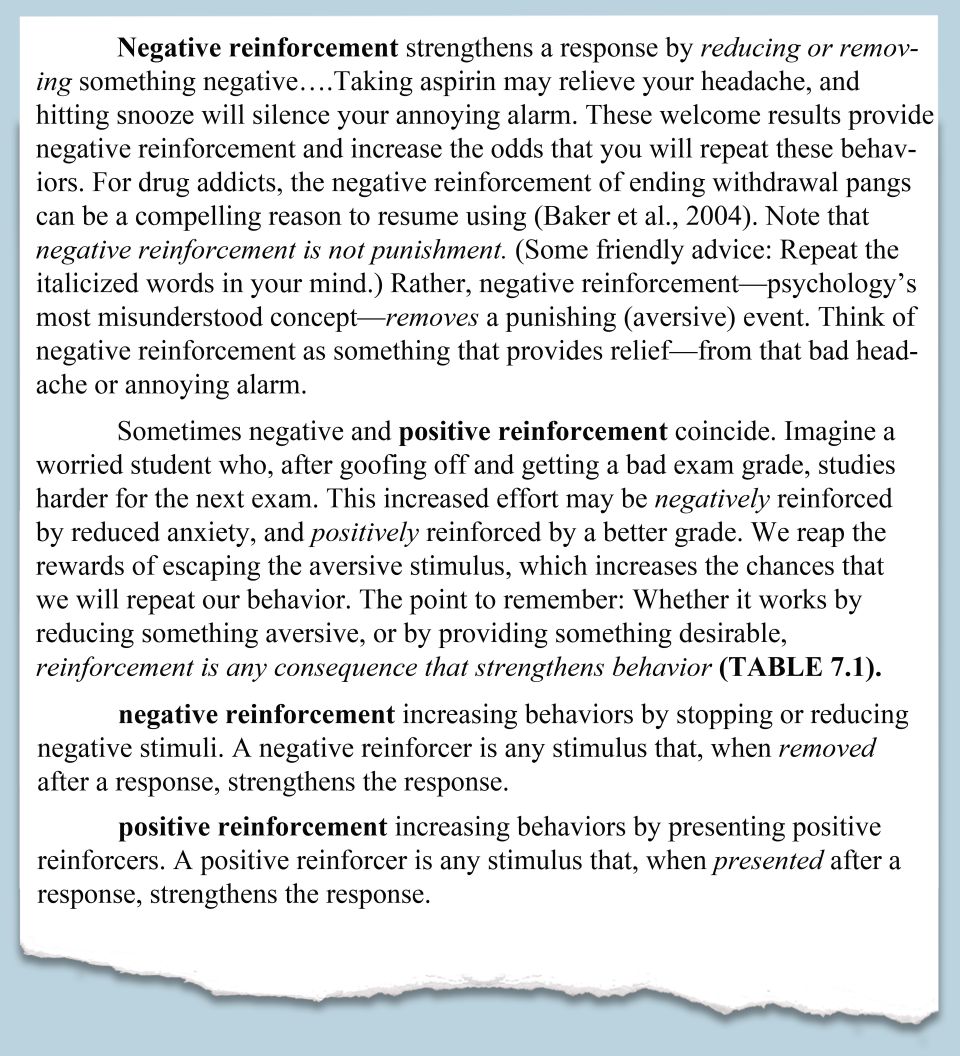
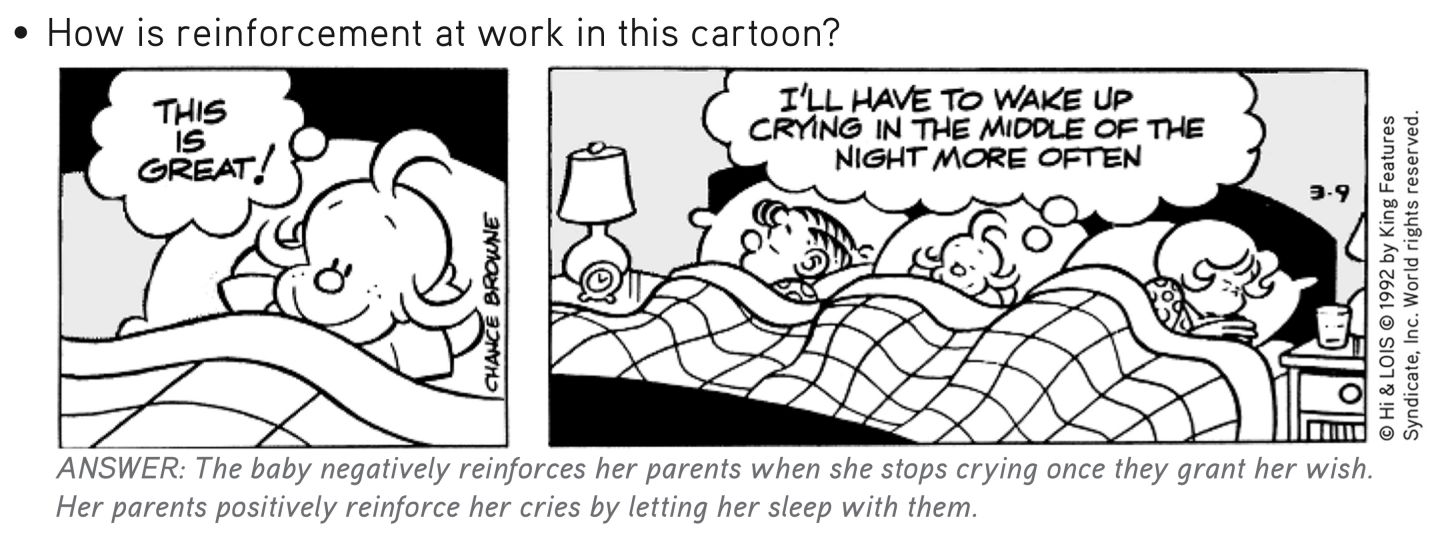
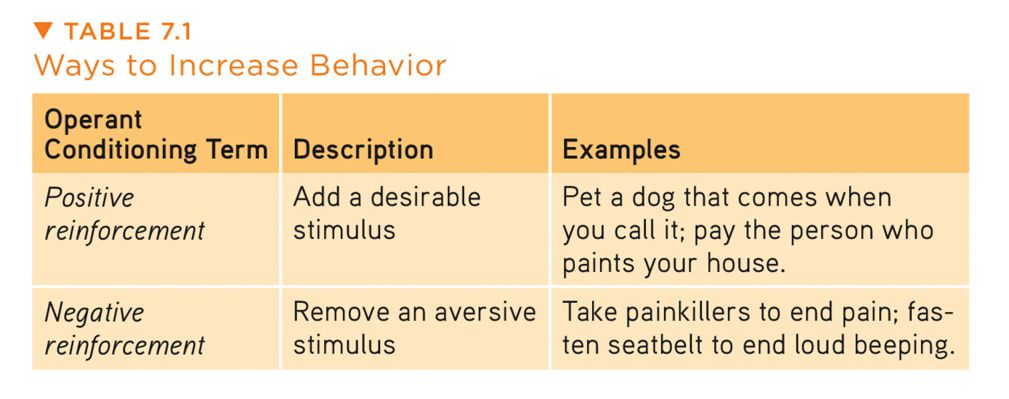
7.18
Question
m6ff16L0f5pAu8+l1vmbaPonGZHfR98ezvlymn/ppRgNJCt+c+ngJyrBktLvQm0LIbC2Rf0264SnFsWI4VxQIz5ENP6Jg7YIQt0hqjM+OD3ZmzjQId00tVvVYR8Dgmdtm1XP+pTegbZjG//qV4mu59caZ4rlMQ4fjLGXUlLzlAHnS21xkjdM2dMtWRyyjed/Ro+rDtMxNTVlKejiPb2jsCA3sDinApOxsg05W1kIlDpv0YO8psxD16z5JO5NDUu9NERmrvucdIvl0ezU8xDwKbjHrcW+YXoQ7B3IIDvz32k++OLj2UI9sFsaTewAv9dduon40XIboFMFAJVA/8z5CrLIZCN5zAnVbeMkfqd0ElaqZcUpgN7tqmT/N5aOXg7+ffVXVUuvSth2vgm/kaUvbFjuFAhRbTNFJfDQGgMmk0MPreW+r7FSl9c2lTUGheoTRjxqPw4nWek9StqspcFQfFTVwx3MFhwh1YXNaIeEQfk0paWMmR1D6/7GukaRYshBjLfqfvfIpQkWm2SU1rvC4hKQdR3CecbWoouPcC3S4Wld40D9q6zW04Lh5qsuxwe1cX0ckA5yOz7ZolU8bczR/MAgBancbXlZWyTSTrfzLCpYodZBXWEehV/vnAYU5oT5I70M92ArLsein1J2/iaKrVLBuiVeOdM0Bq2OGnVvEBrYJ2xznTthN1dquHeyRREpQF1IS2/s4YgHprEAHMiBQmS2WhHSOvhZ0Odl3RueIp+oJUhXVtkyCAperhtZ0o3skECOvLVcByFtSYCItAJI4F7l5j17TLax4deH9Hkx2B/Ha/5mzbdeO29OVe0GIFdbW6QAtyGOfacHfUQRjxHRpGHxazOEinMUuZm7VnT/GloqQLN+XyksLlEFWbunz6l9QmH+kVCVCCE1L4rR/CSenJIWaLv+Ou5UOHRPY+icspdwAwhn7oYrNlXRhF8ia/lNHbacHz8kcKLqWxwlBo6y1PspI5rJ6dWhVF+4huzKS5aTKEIqklbYrjaw3tGvmPCAuN2CHvYo6IIU5SAkt6e+DAgsOX5QG+Ptwj7h2xB94GZk4r0NRboJxkZSY93IDLjz1eR2SLglHSFtTicFKRMwU+mDmk0GQZTWizppBUHFOdMU3lWFxrNzcCs9ou9Gk9zSB7tkSdts2XKolkwAreeEEPJY1/DcWiyyi2litrzPIDzjS7cR7.19
You chose to ask your participants this question: When you feel anxious, how likely are you to read books about meditation?, but that is NOT CORRECT.
This option would tell you something about whether people feel interested in learning about meditation, but it would not give you information about whether people can learn to meditate to reduce their experience of anxiety. To know whether people can learn to reduce anxiety, it is necessary to measure their actual meditation behavior.
Click “Next” to try again to select the best way to measure whether people can learn to reduce anxiety.
7.20
You chose to ask your participants this question: When you feel anxious, how likely are you to talk to other people about meditation?, but that is NOT CORRECT.
Knowing whether people talk to others when they feel anxious does not tell us anything about their meditation behavior. To know whether people can learn to use meditation to reduce anxiety, you need to measure whether they meditate when they experience anxiety.
Click “Next” to try again to select the best way to measure whether people can learn to reduce anxiety.
7.21
You chose to ask your participants this question: When you feel anxious, how likely are you to think about meditating?, but that is NOT CORRECT.
This option would tell us how much anxiety relates to thinking about meditating, but it would not tell us whether people actually learn to meditate when they feel anxious.
Click “Next” to try again to select the best way to measure whether people can learn to reduce anxiety.
7.22
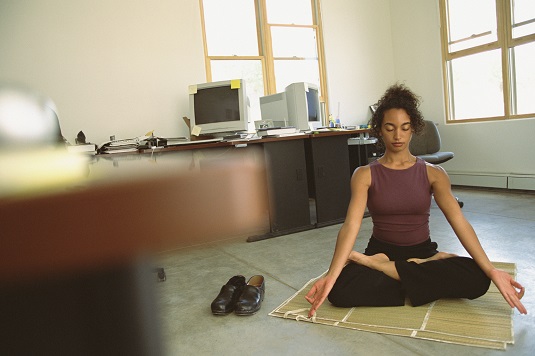
Nice work! You chose an Experimental design, in which you randomly assigned participants either to meditate when feeling anxious, or not to meditate, in order to determine whether people can learn to meditate to reduce anxiety. You also chose an effective way to measure whether people can learn to reduce anxiety, which in this case is how likely people are to meditate when they experience anxiety. You chose to ask participants this question: When you feel anxious, how likely are you to use meditation to reduce your anxiety? (1=not at all likely to 7=very likely).”
Numerous studies have confirmed that people can indeed learn to use meditation to reduce anxiety (Goyal et al., 2014; Sedlmeier et al., 2012). As noted earlier, this type of learning is negative reinforcement, which strengthens a response (meditation) by reducing or removing something aversive, which in this case was anxiety.
Knowing this, you need to consider how you can apply what you’ve learned to the larger population—beyond the people you’ve studied. Consider where you might encounter roadblocks to confidence in your results. What factors might keep you from being able to apply what you’ve learned in a broader context?
7.23

7.24

You tested whether people can learn to reduce anxiety through meditation. You instructed some people to meditate when they felt anxious and others not to meditate when they felt anxious. There are many factors that could affect whether your participants learn to reduce anxiety, and these factors may have little to do with the meditation instructions you gave them! Factors that could interfere with your INTERPRETATION of results are called confounding variables.
Question
Select all of the factors that could affect your confidence in the results of your study:
| ZycNTMvpRoSnXPUZl8FiVl5s+iDEL2Bo | Whether the experimenter makes people feel anxious |
| ZycNTMvpRoSnXPUZl8FiVl5s+iDEL2Bo | Learning disability in the participant |
| 3jskoxIwaHnoYr4Fsi2l/v3etGMIufia | How many times participants have watched movies that make people anxious |
| ZycNTMvpRoSnXPUZl8FiVl5s+iDEL2Bo | Personality traits related to experiencing anxiety |
| 3jskoxIwaHnoYr4Fsi2l/v3etGMIufia | Knowledge of the Tibetan culture |
| 3jskoxIwaHnoYr4Fsi2l/v3etGMIufia | Interest in physical activities, such as running |
Click on "Video Hint" below to see a brief animation describing Confounding Variables.
Video Hint
7.25
Confounding Variables:

7.26

The confounding variables for your study would include those highlighted below:
| Whether the experimenter makes people feel anxious | |
| Learning disability in the participant | |
| How many times participants have watched movies that make people anxious | |
| Personality traits related to experiencing anxiety | |
| Knowledge of the Tibetan culture | |
| Interest in physical activities, such as running |
The highlighted confounding variables might influence your participants in several ways. Some people make others feel anxious. If an experimenter makes study participants feel anxious, those participants might have difficulty learning how to meditate. They might even learn to associate the study with feeling anxious! To reduce this confound, you would need to ensure that the experimenter makes study participants feel comfortable.
You should also determine whether study participants have a learning disability. People who have a learning disability may have difficulty learning to meditate. By keeping track of whether people have a learning disability, you can work to ensure that your participants all have approximately the same learning ability.
The third confounding variable relates to personality traits that might predispose people to experience anxiety. If some of the participants enter your study with significantly higher levels of anxiety than others, that might change your results. You would want to have participants complete a personality test before they enter the study. This way you could be sure that all of your participants have approximately the same levels of anxiety at the start.
Knowing whether people watch anxiety-producing movies, have knowledge about Tibetan culture, or have an interest in physical activities, such as running, does not tell you anything about whether they can learn to reduce their anxiety.
Note that by randomly assigning participants to either the meditation or no meditation condition, you control for many other possible confounding variables. With random assignment, each participant has the same chance of being assigned to each group. This should give each of your groups a balanced number of participants expressing these variations.
Click on "Video Hint" below to see a brief animation describing Random Assignment.
Video Hint
7.27
Random Assignment:

7.28

You may do better on the Quiz if you take notes while watching this video. Feel free to pause the video or re-watch it as often as you like.
REFERENCES
Goyal, M., Singh, S., Sibinga, E. S., et al. (2014). Meditation programs for psychological stress and well-being: A systematic review and meta-analysis. JAMA Internal Medicine, 174, 357–368.
Hofmann, S. G., Sawyer, A. T., Witt, A. A., & Oh, D. (2010). The effect of mindfulness-based therapy on anxiety and depression: A meta-analytic review. Journal of Consulting and Clinical Psychology,78, 169.
Piet, J., Würtzen, H., & Zachariae, R. (2012). The effect of mindfulness-based therapy on symptoms of anxiety and depression in adult cancer patients and survivors: A systematic review and meta-analysis. Journal of Consulting and Clinical Psychology, 80, 1007.
Sedlmeier, P. Eberth, J., Schwarz, M., Zimmermann, D., Haarig, F., Jaeger, S., & Kunze, S. (2012). The psychological effects of meditation: A meta-analysis. Psychological Bulletin, 138, 1139–1171.
7.29
QUIZ: NOW WHAT DO YOU KNOW?